Switch to a curved ultrawide monitor: a one-way street (for gaming and work)

A couple of years ago I changed my lifelong monitor to a 144Hz monitor. It was an outstanding experience on all levels: it was bigger, it had a higher refresh rate and for work and play it was not bad at all. However, the world of technology is like this: you change one thing for another, you like it and you start to wonder if there is something better. In my case, yes: a curved ultrawide gaming monitor.
Why? Because, although I built my computer with the intention of using it to play games, I write for a living (among other things) A larger screen, with better color representation and the ability to have more windows and programs open at the same time helps me to optimize resources and save time. So, I have made the leap to a Huawei MateView GT and this has been my experience.
Choosing the monitor, an odyssey

Let’s start at the beginning: choose the monitor. There are plenty of options and you just have to take a look at the main technology stores to realize it. Choosing one is not as simple as saying “this, it goes, head on”. No, must take into account panel technology, response times, monitor capabilities, size, resolution, etc.
I came from a 24-inch IPS monitor with FullHD resolution at 144 Hz. For that size, that resolution is fine. In fact, it is at the limit. Above 27 inches, FullHD falls short and it is better to jump to 1,440p resolution or more. Above 32 inches, 4K resolution is the safest.
That size began to fall short for me, especially when working with several open windows, editing video and, why not say it, playing. The solution? A curved ultrawide monitor. Why curved? It is relatively simple: to occupy more field of vision with its 34 inches in 21:9 format.

The eye curvature is 1000R and my monitor, the Huawei MateView GT, it has a 1500R curvature. That allows me, sitting a meter or so away from it, to have all the information on the screen in my field of vision. Let’s say I don’t have to turn my head to see what’s on one side or the other. It’s great for work, but it’s also great for play.
panel is VA, which has several advantages over TN and IPS panels. Mainly, the contrast is higher (and blacks deeper), they have good brightness delivery and color reproduction, and they tend to have less leakage than IPS. On the contrary, the response time is lower than the TN and the viewing angles are worse than the IPS. In any case, a VA panel is usually a good option when choosing a monitor (unless we are talking about more professional things, obviously).

This particular model has WQHD resolution (3440 x 1440 pixels), reproduces 90% of the DCI-P3 color space and 100% of sRGB, has a color accuracy of ΔE < 2 (lower is better), and supports HDR. It also has 165 Hz and FreeSync Premium (although, for some reason, it is hidden between the menus). It is, in short, a fairly complete monitor for its price.

Are there other options? Without a doubt. In fact, I thought of the Samsung Odyssey G9, but it is that that monitor is too big. Very big, huge, to the point that I didn’t know if I was going to be able to use it with my 1.70 meter desk without a problem. And its price, of course, which is three times that of this one. In short, this Huawei model has everything you need and, in addition, it has an integrated sound bar that, without giving the best sound in the world, has allowed me to get rid of the mini-system speakers that I used until now.
One way road

Now that we know why this monitor, let’s talk about the experience. We will divide it into two parts: work and play. The first could be summed up in one word: sensational. A screen with this resolution and this format is ideal for working, since it allows you to have several windows open at the same time and see the content well, something impossible on my 24-inch FullHD monitor.
Normally I usually need to have three windows open: the application I use to write (Word, right now), another one with information I’m reading (a press release, a report…) and another one, normally, with the chat with my colleagues. The thing changes depending on the context, but it is understood where the shots go. A monitor with these capabilities and resolution allows you to do it without a problem.

Windows 11, in fact, makes it really easy with the shortcut that appears when you hover over the magnify screen button. I usually use the one divide the screen into three equal blocks, but the division into four windows is also very useful for, for example, writing, having the chat open, watching a video and having a PDF with some graphics at hand, for example. For editing video is also fine. I do it at a basic level, but having the full screen timeline and everything else at hand is really good.
In short, when it comes to working I have noticed that I don’t have to switch tabs so much and that I can have everything I need to write an article on screen. Is a workflow, as they say, much more comfortable. Now, if you usually work with a single screen, I already told you that it is uncomfortable to do it full screen because it expands too much and is not intuitive.

In fact, that is one of the changes that I have had to learn during these days: use the applications in windows, and not full screen. Before, with FullHD resolution and 24 inches, this was more tedious because the content looked small, so I had to use the full window. Now, to avoid that totally unnecessary lengthening, I’ve gotten used to using the apps in windows and, honestly, not too bad.

And how about playing? A fantasy, really. I mainly play shooters and, since its release, ‘Battlefield 2042’ (yes, I like it). Ultrawide monitors tend to generate some debate when playing shooters by field of vision, which is wider and therefore the mouse movement is usually longer to go from one side of the screen to the other. I, however, am very comfortable playing with that FOV, and actually have the FOV all the way up in ‘Battlefield’ to see even more. matter of taste
Not playing competitive games at a competitive level (see ‘Valorant’ or ‘Counter Strike’) I can’t assess whether or not it’s worth it. The vox populi is that no. What is gained in immersion is lost in other things that professional users value. In fact, there are professional players who, out of habit, continue to play in 4:3. I, however, play shooters, story games and some MMOs (I’m waiting for the release of ‘Lost Ark‘ like May water) and I do appreciate a larger screen size and field of view.

The refresh rate of 165 Hz is fabulous and the resolution, together with the curvature, makes the experience much more immersive. It is something very subjective and difficult to translate into text, but the idea is that you have a monitor that looks good, that occupies much more field of vision and that gets you fully into the game. The problem, of course, is that the RTX 3060 gives what it gives, but today the truth is that I have no complaints.
As I said before, it’s a one way street, just like switching to a 144Hz monitor and a 60% keyboard. Is it for all users? No, of course not, but I would encourage anyone who works with multiple windows and likes to play non-competitive games to give it a try.

HUAWEI MateView GT 34” Ultra Wide Curved Monitor 1500R, 165Hz, 21:9 WQHD 3440×1440, 3K+, LCD integrates sound bar with dual 5W speakers and touch volume control, Dual 360º microphones,Black
Reference-www.xataka.com